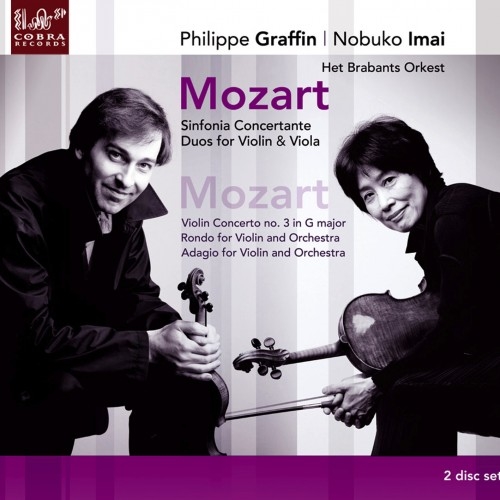Violin Concerto No.3 In G Major K216
Sinfonia Concertante For Violin, Viola K364
Duo For Violin, Viola No.1 In G Major K423
Duo For Violin, Viola No.2 In B Flat K424
Philippe Graffin proves himself an equally eminent Mozartian on this release, a two-disc set with the leading Japanese violist Nobuko Imai. In the sprightly Sinfonia Concertante, two delightful Duos, the Third Concerto plus an Adagio and a Rondo, the multi-tasking Graffin takes on the roles of soloist, chamber musician, director, and composer of his own cadenzas. He is backed by the versatile Brabant Philharmonic Orchestra of Eindhoven, The Netherlands. The stylish packaging features another typical twist by the resourceful Graffin, who commissioned leading journalist and novelist Jessica Duchen to write a short story for the booklet.What status should we assign to an artist’s youthful productions? This question arises when we listen to the first three works on this program: the Concerto KV 216 (1775), the Adagio KV 261 (1776), and the Rondo KV 373 (1781, a bit later, of course, but stylistically akin to the preceding compositions). Commentators have usually compared them to the later, more mature concertante works, in particular to those for piano, taking the opportunity to contrast the “galant” freshness of the former with the expressive power of the latter. Critics also dwell on all the qualities that Mozart’s experience in the realm of opera later contributed to his powers of expression. And indeed, a comparison between these early works and the Sinfonia Concertante, written around the same time as Zaide, confirms this opinion. Not, of course, that Zaide is Die Entführung aus dem Serail, but nevertheless, it was the first libretto which really excited Mozart’s interest, as witnessed by his new preoccupation with the dramaturgy of the piece. It signals a major change in his approach to the classical style. And this exposure to the world of the theatre was to have a direct influence on Mozart’s concertante writing, not only because it would lead to a renewal of the dynamics of the concerto form, but also because it would allow him to reassess the relationship between soloist and orchestra. And this, above all, is what demonstrates the distance between these two “youthful” works on one hand and the Sinfonia Concertante and the two Duets on the other.













